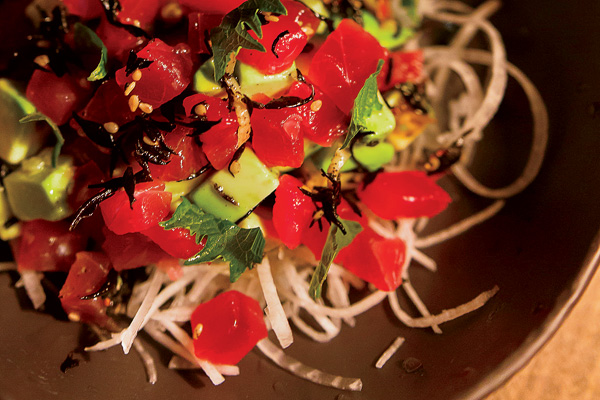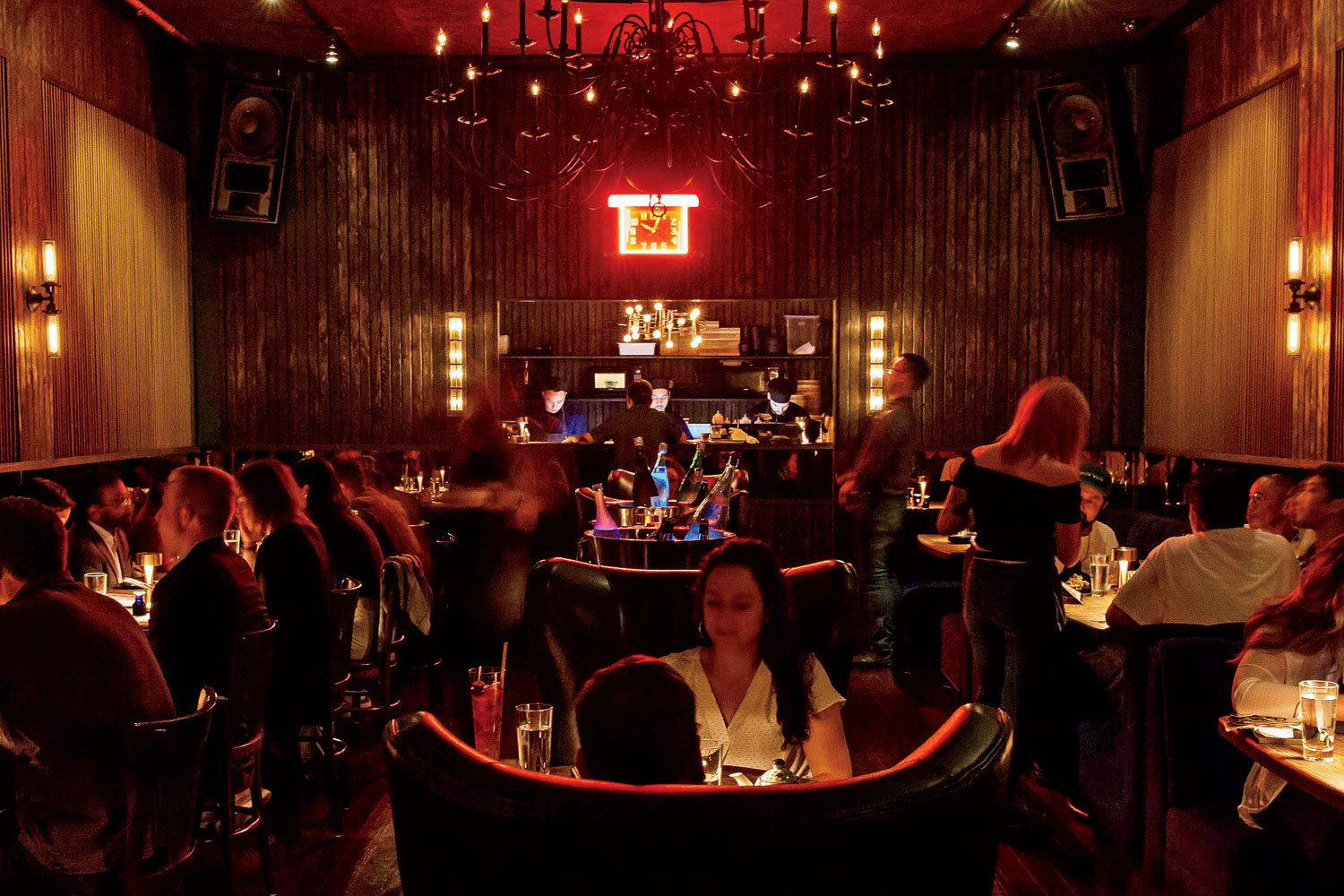Radio Anago isn’t a bad restaurant. It’s worse. It’s a too-clever, glossy pretender from people capable of more. All the smoke and mirrors, all the pumping bass and dimmed lights, only mask the dispiriting truth about the whole enterprise: The food isn’t memorable—except when it’s memorably terrible.
As Hogsalt Hospitality’s CEO, the brilliant restaurateur Brendan Sodikoff has taken on steak at Bavette’s, burgers at Au Cheval, doughnuts at the Doughnut Vault, salads at 3 Greens Market, and everything else at his 15 restaurants in Chicago and New York. They’re all seductive, tasty, and a hell of a lot of fun. They’re always packed, even the ones that don’t take reservations or publish a phone number. So why not Hogsalt-ify sushi, if the right space came along?
It did—on West Kinzie Street, on the same block as Hogsalt’s Gilt Bar and Bavette’s. Sodikoff and his crew transformed the front of an old ceramic tile store into a brightly colored Japanese lounge called Sawada Matcha, which looks like a Candy Land fantasy with an espresso machine. But take one step beyond the thick red velvet curtain in back and you’re in a self-consciously sexy, squintingly dark den bouncing with EDM and illuminated by a red neon clock that tells the time in Tokyo. It’s a startling and unpleasant transition. Under dim orange lamps, couples with tattoo sleeves and Harry Caray glasses sip Negronis and look beautifully bored, adding to the feeling that you’ve stumbled into a Heineken ad set in a Japanese-themed nightclub. “Welcome to Club Sushi,” our sly waitress purred sardonically, as if to further the impression.
The cartoonish menu, with color drawings of its 24 offerings, makes perfect sense in this context. Many of the items—say, a by-the-book miso soup—are almost too familiar. Sly Waitress described the de rigueur uni shooter, a shot glass swimming with sea urchin from Japan, ponzu, yuzu, cucumber, and bonito, as a “great palate cleanser,” then insisted we start with it. Perhaps it was a bit of saucy misdirection, or a prejudgment of our palates. Either way, the salty, briny zap of uni didn’t wipe my palate clean so much as galvanize it for the indignities to come.

To its credit, the tuna poke that followed—slippery cubes of sesame-sprinkled ahi tossed with avocado and wasabi dressing—fared better than its slightly more pedigreed sister: gloppy, oversweet wagyu tartare with seaweed, finely chopped Asian pear, and miso. We were encouraged to scoop both onto garam-masala-dusted taro chips, which sounded good, but the Indian spice mix felt ginned up here. The steamed pork buns, which may as well have hitchhiked to our table from 2007, were soft, puffy, and pleasantly chewy. But the hoisin-painted pork belly tucked inside, along with scallions and pickled cucumber, was tragically undercooked, lending the meat the springy texture of a lukewarm Sausage McMuffin. The seaweed salad, a forest of wakame laid across shreds of cucumber and shaved radish on a long black slate, hit its marks, though the room was so dark that one of my companions had to hold it directly under a lamp to confirm that this was indeed what we were eating.
Radio Anago’s sushi is crafted well enough. The rice was properly cooked, and showy flourishes like mayo art were blessedly absent. The king crab roll with avocado, cucumber, and a crown of fire-red tobiko worked up a nice balanced punch. The warm miso scallop roll with spicy mayo and tempura crunch showcased the buttery mollusk without fanfare. And the vegetarian roll tweaked the sweetness of pickled plum with a minty shiso leaf and cucumber. All were solid, though they wouldn’t exactly put Kai Zan on notice. To quote one of my tablemates: “This is pretty good sushi. It’s, like, the 28th best in Chicago.”
It’s harder to summon even faint praise for the nigiri—forgettable slabs of hamachi, unagi, octopus, and the like, all slathered with so much potent sesame oil that even the boldest-tasting fish drowned beneath it. I did enjoy the tuna flight: The luscious pieces of otoro, akami, toro tartare, and chu toro were a satisfying study in the delicate flavors of Japan’s favorite fish.
But that moment of pleasure was fleeting, obliterated by the arrival of Radio Anago’s centerpiece dish: the disturbing Houji fried chicken. The restaurant is inexplicably proud of it, serving it with gold scissors and talking it up nonstop. But what arrived was three overbattered, burnt boneless thighs. They resembled something between a trio of burgers left overnight on a grill and decomposing limbs in a serial killer’s basement. A smattering of matcha didn’t even register. The sprinkling of gold flakes lent a top note of bullshit. And that was the good part. The skin had an off-putting tang and a rancid flavor, which seeped into the dried-out meat and left a greasy feeling on the roof of my mouth that, like the demonic clown from It, could not be destroyed. At $26, it’s the worst new dish of the year. Maybe the decade.

“Bad news,” said our waitress at this point. At first, I thought she was going to tell us we had to finish the chicken, but it turned out the ice cream machine was broken. Our only dessert option was macarons. Of the 10 flavors, we ordered four (pistachio, lemon, passion fruit, and birthday cake), and all were served cold, which didn’t help their leaden consistency. But this was a Hogsalt joint, so at least the cocktails, a roster of sake-based drinks and highballs, were well made. A fortifying postdinner Sazerac, served in a properly chilled glass, left me in good enough spirits to almost forget the meal I’d just eaten. Almost.
What Sodikoff has done in the past eight years is amazing. His best restaurants capture something elemental about their respective genres, stripping away the nonsense to give you the good stuff. But Radio Anago is a half-assed afterimage of its predecessors. It has the sexy Hogsalt vibe but not the food to go with it—a lazy pastiche sprinkled with gold flakes with nothing underneath.



